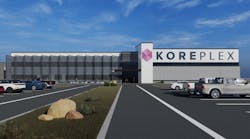While the automotive industry has taken the first steps in establishing lithium-ion battery manufacturing in North America, a new venture is coming online in Arizona, and it’s one of the first independently operated cell manufacturing in the U.S. Called KorePlex, the gigafactory developed by Kore Power, a U.S.-based developer of lithium-ion battery cells and modules for the e-mobility and energy storage sectors, is getting an efficiency and production assist from Honeywell’s end-to-end, integrated Battery Manufacturing Excellence Platform (MXP).
The facility promises to apply robust automation and digital technology to battery manufacturing, which has been largely manual. The new facility isn’t tied to a joint venture and will manufacture cells for customers in several industries. “I think that's the big difference, and that's going to, hopefully, give them the competitive advantage to be successful in the market,” says Frederick Westerberg, vertical customer marketing director at Honeywell.
According to a National Renewable Energy Lab (NREL) report, traditional lithium-ion cell manufacturing has many inefficient, manual operations, leading facilities to commonly operate at a 70% production yield at steady-state. “KorePlex will be a new state-of-the-art, lithium-ion battery facility, that uses end-to-end connectivity, digitizing the entire process for a more sustainable and novel approach to cell production,” adds Alec Falzone, lithium-ion battery initiative leader at Honeywell.
KorePlex will be the first fully digitized and integrated lithium-ion cell manufacturing facility using MXP. With continuous closed-loop control, Honeywell’s Battery MXP will enable Kore Power to visualize and control its entire lithium-ion battery production process in real-time, from mixing, coating, assembly to its formation-finishing area. This centralized approach will allow Kore Power to reach target capacity faster, while improving production yields and improving safety.
Meanwhile, the digital Honeywell MXP platform lets users scale their enterprise and achieve operations with superior yields starting from the first day of operations. Coupled with production optimization and improved efficiencies, the technology can reduce energy consumption. Also, the platform provides online quality management with complete production traceability/genealogy of the cells produced.
Efficiency is vital in cell production because battery cost is often the main driver of high prices for products utilizing lithium-ion. For example, electric vehicles are expensive because their batteries are expensive. The first step to solving that market conundrum is to reduce production costs, according to Westerberg.
“We're dealing with lithium, nickel, cobalt, different oxides of metals, foils. You can't scrap these things easily. They're extremely expensive,” he says. “Getting efficiencies up is extremely important to reduce production cost to the point where EVs and energy storage are more affordable.”
That’s especially true as the competition heats up. KorePlex may be one of the first to come online, but there's a laundry list of others soon to follow. All the new gigafactories will be competing for those expensive materials. “It's critical to use what [materials] you have efficiently, so using this new state-of-the-art automation and connectivity, these companies are going to be ahead of the game,” Falzone says.
They’ll also be ahead of the game when it comes to sustainability. “Sustainability and efficiency, these things go hand-in-hand. You can't have one without the other,” Westerberg says.
An operation can’t be sustainable without high yields and high throughput. So, addressing the efficiency of the operation by integrating individual machines into a holistic system, and then optimizing the operation is the one major area of sustainability that MXP can impact, according to Westerberg.
Falzone adds traceability and genealogy insights can pinpoint where something occurred. “So instead of shipping a million cells to your recycling partner, which have to be shipped to the recycling facility because it's not on the same site, you would ship a fraction of that,” he says. “The visibility into the process piece by piece gives you that insight to make intelligent decisions.”





